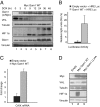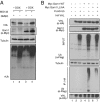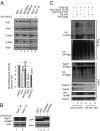BC-box protein domain-related mechanism for VHL protein degradation
- PMID: 24145437
- PMCID: PMC3831490
- DOI: 10.1073/pnas.1311382110
BC-box protein domain-related mechanism for VHL protein degradation
Abstract
The tumor suppressor VHL (von Hippel-Lindau) protein is a substrate receptor for Ubiquitin Cullin Ring Ligase complexes (CRLs), containing a BC-box domain that associates to the adaptor Elongin B/C. VHL targets hypoxia-inducible factor 1α to proteasome-dependent degradation. Gam1 is an adenoviral protein, which also possesses a BC-box domain that interacts with the host Elongin B/C, thereby acting as a viral substrate receptor. Gam1 associates with both Cullin2 and Cullin5 to form CRL complexes targeting the host protein SUMO enzyme SAE1 for proteasomal degradation. We show that Gam1 protein expression induces VHL protein degradation leading to hypoxia-inducible factor 1α stabilization and induction of its downstream targets. We also characterize the CRL-dependent mechanism that drives VHL protein degradation via proteasome. Interestingly, expression of Suppressor of Cytokine Signaling (SOCS) domain-containing viral proteins and cellular BC-box proteins leads to VHL protein degradation, in a SOCS domain-containing manner. Our work underscores the exquisite ability of viral domains to uncover new regulatory mechanisms by hijacking key cellular proteins.
Keywords: hypoxia; oncoviral proteins; ubiquitylation.
Conflict of interest statement
The authors declare no conflict of interest.
Figures







Similar articles
-
VHL-box and SOCS-box domains determine binding specificity for Cul2-Rbx1 and Cul5-Rbx2 modules of ubiquitin ligases.Genes Dev. 2004 Dec 15;18(24):3055-65. doi: 10.1101/gad.1252404. Genes Dev. 2004. PMID: 15601820 Free PMC article.
-
Role of SOCS and VHL Proteins in Neuronal Differentiation and Development.Int J Mol Sci. 2023 Feb 15;24(4):3880. doi: 10.3390/ijms24043880. Int J Mol Sci. 2023. PMID: 36835292 Free PMC article. Review.
-
Identification of Elongin C and Skp1 sequences that determine Cullin selection.J Biol Chem. 2004 Oct 8;279(41):43019-26. doi: 10.1074/jbc.M408018200. Epub 2004 Jul 27. J Biol Chem. 2004. PMID: 15280393
-
EC5S ubiquitin complex is recruited by KSHV latent antigen LANA for degradation of the VHL and p53 tumor suppressors.PLoS Pathog. 2006 Oct;2(10):e116. doi: 10.1371/journal.ppat.0020116. PLoS Pathog. 2006. PMID: 17069461 Free PMC article.
-
The Roles of Cullin-2 E3 Ubiquitin Ligase Complex in Cancer.Adv Exp Med Biol. 2020;1217:173-186. doi: 10.1007/978-981-15-1025-0_11. Adv Exp Med Biol. 2020. PMID: 31898228 Review.
Cited by
-
Regulation of cancer stem cells by RING finger ubiquitin ligases.Stem Cell Investig. 2014 Feb 9;1:5. doi: 10.3978/j.issn.2306-9759.2014.01.01. eCollection 2014. Stem Cell Investig. 2014. PMID: 27358852 Free PMC article. Review.
-
WSB1 promotes tumor metastasis by inducing pVHL degradation.Genes Dev. 2015 Nov 1;29(21):2244-57. doi: 10.1101/gad.268128.115. Genes Dev. 2015. PMID: 26545811 Free PMC article.
-
Human Papilloma Virus Increases ΔNp63α Expression in Head and Neck Squamous Cell Carcinoma.Front Cell Infect Microbiol. 2020 Apr 8;10:143. doi: 10.3389/fcimb.2020.00143. eCollection 2020. Front Cell Infect Microbiol. 2020. PMID: 32322564 Free PMC article.
-
USP9X destabilizes pVHL and promotes cell proliferation.Oncotarget. 2016 Sep 13;7(37):60519-60534. doi: 10.18632/oncotarget.11139. Oncotarget. 2016. PMID: 27517496 Free PMC article.
-
Enhanced glucose metabolism through activation of HIF-1α covers the energy demand in a rat embryonic heart primordium after heartbeat initiation.Sci Rep. 2022 Jan 7;12(1):74. doi: 10.1038/s41598-021-03832-5. Sci Rep. 2022. PMID: 34996938 Free PMC article.
References
-
- Hershko A, Ciechanover A. The ubiquitin system. Annu Rev Biochem. 1998;67:425–479. - PubMed
-
- Petroski MD, Deshaies RJ. Function and regulation of cullin-RING ubiquitin ligases. Nat Rev Mol Cell Biol. 2005;6(1):9–20. - PubMed
-
- Yan Q, et al. Identification of Elongin C and Skp1 sequences that determine Cullin selection. J Biol Chem. 2004;279(41):43019–43026. - PubMed
-
- Duan DR, et al. Inhibition of transcription elongation by the VHL tumor suppressor protein. Science. 1995;269(5229):1402–1406. - PubMed
Publication types
MeSH terms
Substances
Grants and funding
LinkOut - more resources
Full Text Sources
Other Literature Sources

